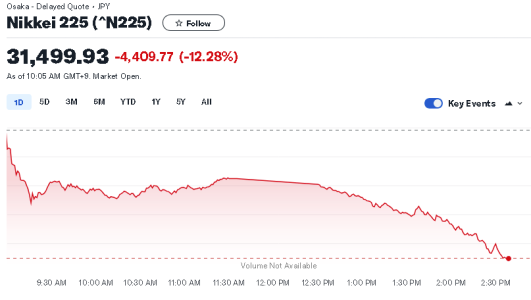the street dot com
Most recent market Circuit Breakers:
October 19, 1987
Though there was no halt on “Black Monday,” it is a day worth noting as it caused a
22% fallout in the market. This event brought more attention to the need for modern preventive measures that are aimed at avoiding massive sell-offs in a single day. The guidelines for market halts will be discussed later.
Oct. 17, 1997
So called “circuit breakers” caused the shutting down of the NYSE floor as well as the Nasdaq. These protections were implemented as a result of the
1987 crash. At the time, the setup was a 30-minute shutdown if the Dow decreased by 350 points. A second trigger with an additional 200-point loss would close the market for the day.
9/11 Attacks
The tragic events of September 11 caused the NYSE to not open that Tuesday morning. The Nasdaq also remained closed. The markets remained closed until September 17, as fears were prevalent that the quake of panic over the attacks would lead to massive sell-offs. When the NYSE did finally open, the market would lose 7.1%.
Dec. 1, 2008
This was the last time we saw the NYSE halted for big sell-offs. It is hard to forget the turmoil of the 2008 housing crisis that put the
country into recession. Car companies were bailed out. Financial institutions were liquidated. Massive amounts of capital disappeared in days from the markets.
July 8, 2015
The NYSE was halted for a
technical glitch that caused the exchange to be down for a few hours.
March 9, 2020 - What Caused It?
Monday morning’s halt and eventual reopening led to an all-day event of chaos. The fallout that led to the halt has been a slow burn over the past few weeks. It began with coronavirus fears, and what the spread of the virus could mean for the global economy. That has escalated into a much broader situation. A drastic 20+%
pullback in oil prices, combined with declining interest rates on treasuries have compounded the issue over coronavirus concerns.
The Dow Jones Industrial Average finished 7.79% lower Monday. That’s a 2,014-point decline. The S&P 500 decreased a comparable 7.60%, finishing 225.81 points lower. Within a broader market sell-off, banks have been smacked over fears by investors that net interest margins could really get squeezed, thanks to what’s happening on the bond front. Transportation stocks and shipping stocks are suffering thanks to the virus concerns. Energy stocks are under serious heat due to the fallout in oil prices.
Where things go from here is a question that will be on everyone’s mind for the next few days. The coronavirus hasn’t gone away, and there’s real potential for continued problems. Low rates are likely to continue putting pressure on bank stocks, and transportation stocks seem a prime target to continue to suffer from travel fears over the coronavirus. Unless oil rebounds, energy stocks seem to have a great many headaches in their future.
Put frankly, we’re in uncharted waters.
March 12, 2020
Just three days after a market halt earlier in the week, trading was halted yet again.
Tensions from growing coronavirus concerns and sudden news about the spread - the WHO announcing a pandemic, the NBA suspending its season, President Trump's speech and travel ban from Europe - panicked investors, and not long after the opening bell the New York Stock Exchange
halted trading on the S&P 500 for 15 minutes after stocks fell 7%. The Dow and Nasdaq Composite were halted as well.
Wall Streetfutures, meanwhile, hit "limit down" levels.
What are the Modern Qualifications for a Market Halt?
The NYSE operates on a set of qualifications that must be met in order for a trading halt to occur. A level 1 trigger requires a 7% decline of the S&P 500. In the event that this requirement is met, the New York Stock Exchange will be halted for 15 minutes. This is what we saw Monday, when trading lasted for just four minutes in the morning before reaching that 7% loss.
After trading is resumed, the S&P 500 has to increase its decline to 13% in order to trigger a second halt. This halt once again lasts for 15 minutes.
Once trading is resumed for the second time, a level 3 trigger requires the market to reach a 20% decline. Once that happens, trading is halted for the third and final time. It does not continue for the rest of the day.

BY
DAVE BUTLER





